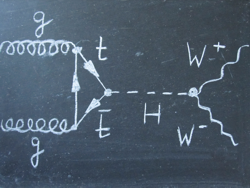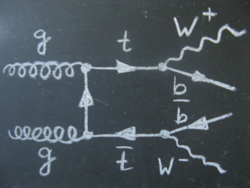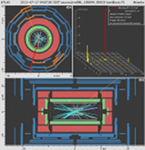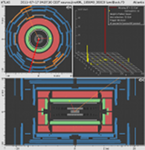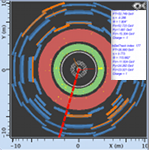Higgs Particle
This short chapter tries to give you some insight into the search for this new particle at the LHC and its recently reported results.
While the LHC is searching for many new particles the Higgs particle is the most famous.
Its discovery would give evidence for a theory that was concocted in the mid-1960's describing a mechanism that gives mass to all particles of the standard model.
One can derive from symmetries that immediately after the big bang all elementary particles were massless.
The theory suspects that a medium called the Higgs field spread out through our universe a trillionth of a second after the big bang.
Particles interacting with this field have a mass different from zero: The more they interact with the medium, i.e the larger their observed masses are, the more force is needed in order to accelerate them inside this medium.
To test the idea of a Higgs field experimentally an observable quantity has to be found that is linked to it.
Quantum field theory requires that a particle associated to the Higgs field has to exist and that this particle can be created by exciting the field.
This is just like like creating little curls in a fluid or gas.
These curls are the quanta of the Higgs field excitations and are the actual Higgs particles.
They are massive and extremely short-lived.
Before they can reach the detectors they decay into other particles so that they can only be found on the basis of their decay products.
After three years of data taking and analysis we now have a good idea of the mass of the Higgs particle.
Because of its mass of 125 GeV it may decay into a wide range of particle.
Measuring the ratios with which the Higgs particle decays to other particles is an ongoing endeavour and will clear up whether what we call the Higgs particle is really the Higgs particle as predicted by theory.
In the diagram below you see theoretical predictions and recent experimental results from ATLAS and CMS detailing the fractions (y axis) of the most important decay processes of the Higgs particle.
Additionally, you can see shaded areas inside the diagram.
These areas show Higgs masses that prior to its discovery had been excluded after analyses by ATLAS and CMS at the LHC (with 95% confidence) or by LHC's predecessor, the LEP experiment, 10 years ago.
The influence of the Higgs mass (x axis) on these fractions is shown as well.

Pay attention to the blue, dashed line (indicated with WW). Since searching the Higgs particle by observing excesses in events with pairs of bottom and anti-bottom quarks (due to the vast background) is difficult, this line tells us: The decay of the Higgs particle into two W particles is the most promising decay mode in the complete and still allowed mass range. These W's have opposite electric charges since the Higgs particle is electrically neutral.
The problem is: If a Higgs particle decays into two W's it will look like the production of two W's with opposite electric charge.
This production process is allowed by the Standard Model and has nothing to do with the Higgs production (see right Feynman graph below).
Furthermore the latter process (production of two W's without participation of the Higgs) is far more frequent (4-10 times depending on the mass).
But how can you then distinguish between these two processes?
It is possible by employing additional physics quantities.
Learning how to use them will help you distinguish between these processes.
Particle physicists call this: increasing the signal to background ratio.
So the channel we will be interested in when searching for the Higgs is the WW decay mode.
Both W particles decay independently from each other following the laws of the Standard Model.
A single W particle can decay into a pair of either quark and anti-quark or lepton and anti-lepton.
We want to have a look at the latter decay mode, where both W particles will decay into a pair of lepton and anti-lepton, excluding tau leptons due to their complicated identification.
Physicists are calling this decay mode H→WW→lνlν or WW→lνlν short, where l stands for an electron, muon, positron or anti-muon and ν for a neutrino or anti-neutrino.
To increase the signal to background ratio in the chosen decay mode we will concentrate on the angle between our two detectable leptons in the plane perpendicular to the beam pipe.
This angle is called opening angle.
By taking spin relations of the produced particles into account we expect to find the Higgs events mainly at angles less than 90 degrees while Standard Model WW events appear in the whole angle range in which they prefer to appear at angles greater than 90 degrees.
Putting this information in histograms will yield a nice visualisation for further analysis.
Signal vs Background
Here are two more Feynman diagrams showing the production and decay of the Higgs particle and one background event (in this case: production of a heavy top quark pair).
WW events
-
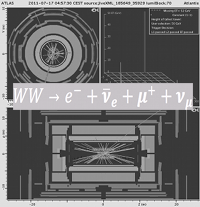 Here you can learn how to identify WW events.
Here you can learn how to identify WW events.
Now that you know how to find WW events, you can proceed to the measurement.

